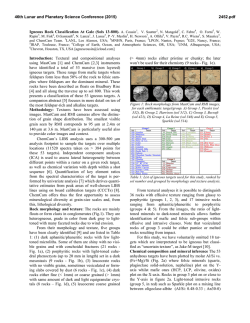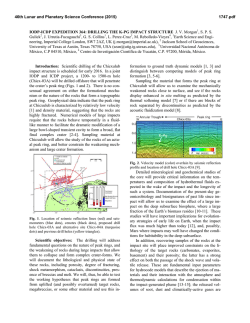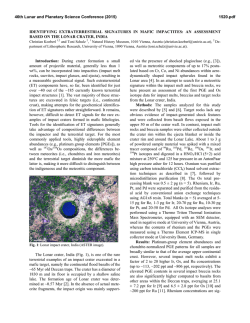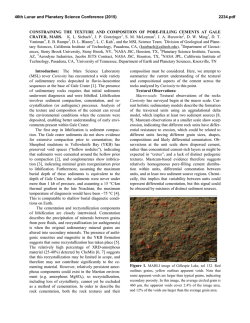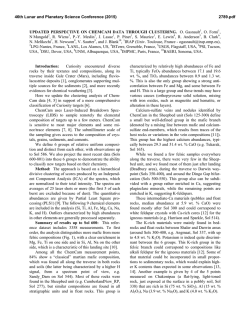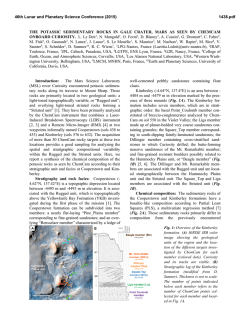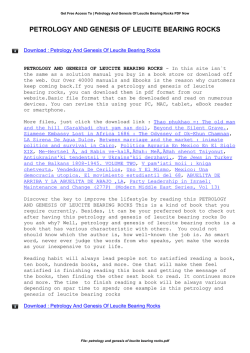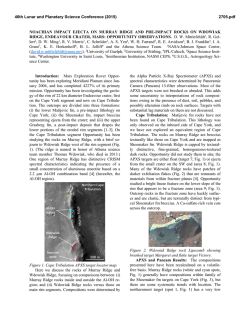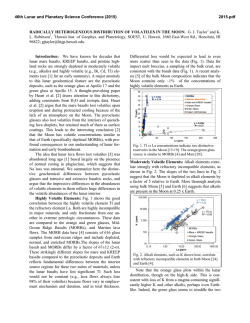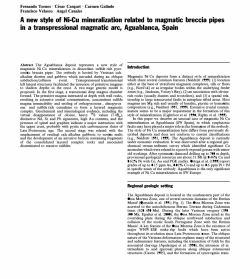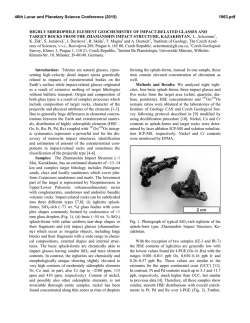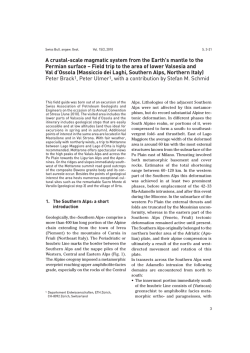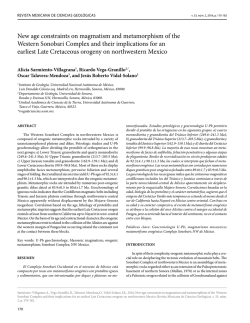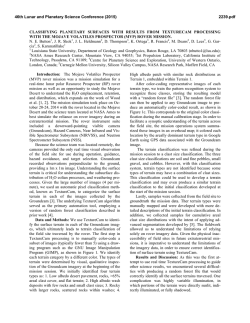
1943 - USRA
46th Lunar and Planetary Science Conference (2015) 1943.pdf GRANODIORITE AND AN ALKALINE SUITE ANALYSED BY CHEMCAM AT GALE CRATER V. Sautter1, M.J. Toplis2, R.C. Wiens3, A. Cousin3, C. Fabre4, O. Gasnault2, S. Maurice2, O. Forni2, E.M. Stolper5, J. Lasue2, A. Ollila6, M. Fisk7, N. Mangold8, P.-Y. Meslin2, P. Beck9, P. Pinet2, L Le Deit8, W. Rapin2, J.C. Bridges10, D. Dyar11, J.J. Wray12, D. Vaniman13, S. Le Mouélic8, H. Newson14. 1IMPMC, Muséum d’Histoire Naturelle, Paris, France, 2IRAP, Toulouse, France, 3Los Alamos National Laboratory, Los Alamos, NM, USA, 4G2E, Nancy, France, 5Caltech, Pasadena, CA, USA, 6Chevron Energy Technology Company, Houston, TX, USA, 7College of Earth, Ocean, and Atmospheric Sciences, OR, USA, 8LPG, Nantes, France, 9Institut de Planétologie et d’Astrophysique, Grenoble, France, 10Space Research Centre, Dept. of Physics and Astronomy, University of Leicester, UK, 11Mount Holyoke College, South Hadley, MA, USA, 12Georgia Institute of Technology, Atlanta, GA, USA, 13Planetary Science Institute, Tucson, AZ, USA, 14Institute of Meteoritics, Albuquerque, NM, USA.[[email protected]] Introduction: Fifty three igneous float rocks were identified along the Curiosity’s traverse at Gale crater , between sol 13 and 800 [1, 2, 3]. Textural and compositional analyses using MastCam, ChemCam Remote Micro Imager (RMI) and Laser Induced Breakdown Spectroscopy (LIBS) with a ∼300-500µm laser spot allow recognition of mafic and felsic igneous targets including 24 feldspar-rich rocks (over 95 locations totaling 2850 laser shots). At Bradbury rise (sol 13 to 45), located at a distal portion of the alluvial fan derived from Peace Vallis, a fluvial channel cutting through the northern rim of Gale crater, 3 light-toned rocks were initially observed (Blanchet, Stark and Thor Lake) [1]. Since the rover left the fluviolacustrine deposit of Yellow Knife Bay on sol 326, 21 additional feldspar-rich rocks were recognized within Hummocky plains and Rugged units. Methodology: Grain size, shape and distribution were first assessed using MastCam (0.22 and 0.074 mrad/pixel) and RMI cameras (0.0196 mrad/pixel). The smallest visible grains with RMI (assuming a 2 pixels limit resolution) corresponds to 94 µm at 2.4m, 141µm at 3.6m. Moreover, ChemCam LIBS offers the first opportunity to assess mineralogical diversity at grain-scales and, from this, lithological diversity. Independent component analyses (ICA) allow spectral classification of spectra and assessement of lateral heterogeneity between different points within a raster on a given rock. Key element ratios (Al/Si, (Fe+Mg)/Si) and oxide concentrations are derived from the spectra using univariate analysis [4], a method that quantifies the peak areas of well-chosen LIBS lines that are related to concentration thanks to calibration curves using on-board calibration targets (CCCTs: 3 basaltic glasses 1 felsic macusanite glass and 4 ceramics [4,5]). Whole rock estimates are obtained by averaging large rasters (> 9 points) on finegrained homogenous targets. For heterogeneous targets such as phenocrysts in fine-grained mesostasis, whole rock compositions are calculated using modal proportions of felsic and mafic phases and their respective molecular compositions. Rock morphology and texture: Felsic rocks are mainly float faceted by wind erosion. Some targets form 810 cm clasts in polymict conglomerates (Fig.1a) associated with the Peace Vallis alluvial fan system. From morphology, color, grain size, and patina, 3 different classes of rocks have been identified (Fig.1). Porphyritic rocks (9 targets: group 2 in [2]) are defined by light-toned, euhedral white crystals 1-20 mm in length (48 to 65% of the rock volume) set in a dark gray mesostasis (Fig.1a). Light-toned coarse granular rocks (9 targets: group 5 in [2]) are dominated by leucocratic minerals (≈ 80% of the rock volume, Fig.1b). Pearly coarse crystals (>5mm) are locally intergrown with finer (1mm) rectangular translucent gray grains in a graphic texture. Aphyric leucocratic rocks (6 targets: group 3 in [2]) do not have visible grains (less than 100 µm at 2.5 meters, Fig.1c). Sometimes they have shiny scoriaceous surfaces. Porphyritic targets (group 2) and aphanitic to glassy rocks (group 3) are effusive whilst group 5 has granoblastic textures corresponding to intrusive rocks. Vesiculated rocks of group 3 could be pumice of molten rocks resulting from impact. a 1cm b 1cm cc 5cm Figure 1: Rocks texture from MastCam, MAHLI: a) porphyritic clast Harrison in a polylithic conglomerate (MastCam); b) coarse intrusive Clinton (MAHLI); c) vesiculated: Blanchet (Mastcam). Chemical composition and mineral inference Hierachical divisive clustering [6] and ICA [7] of the 95 LIBS Spectra on the 24 targets show that 80% of group 5 spectra are Ca, Al and Si-rich but are Ba-poor (<100ppm [8]). The corresponding points are interpreted as plagioclase feldspar. For a given ICA Si score, group 5 points are Al-rich compared to spectra of group 3 which are defined by high K, Si, Na and Ba concentration (> 1500 ppm Ba [8]). The latter are consistent with a K-feldspar- rich composition. Group 2 is dominated (> 60%) by mafic elements (Ti, Fe, Mg) enrichment corresponding to the mafic mesostasis. The white phenocrysts have Ca-rich cores and a K, Na–rich rim. The 24 targets have been plotted in Al/Si vs. (Fe+Mg)/Si (mole %) diagrams (Fig. 2) where felsic minerals (quartz, plagioclase solid-solution, nepheline) plot on the Y-axis whilst mafic phases (HCP, LCP, olivine, oxides) plot on the X-axis. Felsic rock compositions plot on (or close to) the Y-axis. Light-toned rocks such as Clinton (group 5: red symbols) plot on a mixing line between oligoclase-albite (Al/Si: 0.48- 46th Lunar and Planetary Science Conference (2015) 0.33; An30-0) and a silica-rich component.Vesiculated light-toned rocks such as Becraft (group 3: brown symbols) have compositions close to the macusanite CCCT, a rhyolitc glass (Al/Si < 0.33), indicative of silica satured rocks mixed with an alkali-feldspar component. Porphyritic class rocks such as Harrison (group 2: green symbols) plot on the same mixing line between oligoclase (Al/Si 0.38-0.44; An 10-28) and mafic composition as gabbro [2]. However porphyritic class mafic points concentrate in the central part of the line indicative of very fine grained (with respect to the LIBS beam size) or glassy basaltic mesostasis. Figure 2: Al/Si vs. (Fe+Mg)/Si plot from univariate data processing. The Purple symbols are the CCCTs: macusanite a ryolitic glass plot on the Y-axis and a basaltic glass which plots on the basalt mixing line. Whole rock estimations distinguish intrusive rocks of group 5 (red symbols, Fig.3) which are quartz- normative, alkali-poor with dioritic to granodioritic composition, from effusive rocks (group 2- 3) that plot in the alkali domain. Porphyritic effusive (group 2) rocks plot in the trachyandesitic field (Fig. 3) whilst felsic targets of group 3 with SiO2 >64% and Na2O+K2O > 10% are consistent with trachytic composition. From their vesiculated texture they could be ejecta. Alternatively these liquids could be related to basanites [2] and trachyandesites of class 3 by low pressure crystallization of primary basalt produced by 6% melting of the Mantle at 1 Gpa. Figure 3 TAS diagram: the targets with significant number of analyses for whole rock estimation purpose are plotted only. The black curve is the alkalinesubalkaline boundary curve; the dashed green line is the alkaline trend: the red dashed ellipse includes 1943.pdf quartz-normative intrusive rocks; blue and light green dots corresponding to basanite (group 1) and gabbro (group 4) are described in [2] Trachy andesite (Gr.2) Peacok Hill Robin Hood Stock Falla Horlick Harrisson Bindi Angelo Albee Trachyte (Gr.3) Blanchet Stark Chakonipau Sledger Becraft Meeting House Diorite-Granodiorite (Gr.5) Clinton Sparkle Noriss 2 Bird River Liitle Wind River Ross Wilkinson Dougalls Nita List of igneous feldspar-rich targets used for this study.The numbers in parentheses refer to the group defined in [2]. Discussion & conclusion:This work provides the first in situ detection of low density leucocratic igneous rocks at the surface of Mars. K-feldspar bearing rocks from the alkalin suite looks like felsic clasts described recently in two SNC meteorites (NWA 7034, and 7533, 9, 10), the first Noachian breccia sampling the martian regolith. The latter rock-type is unlike anything proposed in the literature for Mars but resemble the Archean TonalitesTrondhjemitesGranodiorites’s on Earth related to the building of the continental crust. Note that the studied rocks are present as alluvial fan detritus in the Gale landing site i.e. the Curiosity rover is currently probing the Noachian crust eroded from the rim of Gale crater. They would be samples of a 23km thick crustal sequence that is normally hidden below the basaltic surface. Our finding would be consistent with quartzo-feldspathic material detected locally from orbit in the southern highlands but interpreted as anorthosite or granite [12, 13, 14]. If so, felsic material should be widespread in Noachian terrains and consistent with the low average density for the southern highland crust inferred from geophysic [15] but considered up to now in contradiction with basaltic remote sensing measurement obtained over the past 30 years. References:[1] Sautter et al. 2014 JGR-Planets doi :10.1002/2013JE004472 [2] Cousin et al. 2015 this conference LPSC46th [3] Sautter et al. 2013 LPSC 45th Abst. 1369, [4] Fabre et al. 2014, SAB, 99, 34-51 [5] Fabre et al. 2011, SAB, 66, 280-289, [5] Gasnault et al. 2013 LPSC 44th Abstr. 1996, [6] Forni et al. 2013 SAB, 86, 31-41, [7] Ollila et al. 2014 , JGR-Planets 119, 1-31, [9] Agee et al. 2013, Science 339,780-78512764 [10] Humayun et al, 2013, Nature, doi : 10.1038, [11] Collinet et al. 2014, LPSC 45th Abstr. 2839, [12] Carter & Poulet 2013, Nature Geoscience 6,1008-1012, [13] Wray et al. 2013, Nature Geoscience, 6, 1013-1018. [14] Bandfield et al. 2004, JGR-Planets 109, doi :10.1029/2006JE002477 [15] Belleguic et al , 2005, JGR -Planets, doi: 10.1029/2005JE004234.
© Copyright 2025
